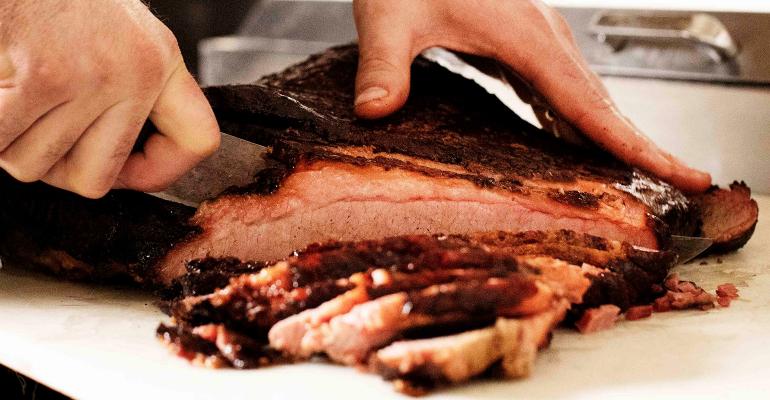Sponsored by Hormel Foodservice
Smoked beef brisket is hot. For at least a century, this barbeque staple was mostly a regional offering in Texas and neighboring states. Now, on the heels of America’s passion for DIY barbeque, beef brisket is pursuing a cross-country migration onto restaurant menus.
Simply sliced and plated or parked between slices of white bread, brisket is easy to menu. But its great smoky flavor is inspiring chefs to cube it for soups and side dishes, chop it for nachos and tacos and shred it for breakfast hashes.
Yet for all its soaring popularity, brisket comes with challenges. If purchased whole, this large cut of beef requires careful and costly trimming. It also requires a smoker, which consumes a good bit of space and an experienced cook to operate it. Perhaps most challenging, smoking brisket takes 12 hours or more to reach that magic, melt-in-your-mouth-tenderness temperature of 203° F. Hitting that mark consistently takes practice and skill.
Those aren’t the only demands faced by restaurant operators who want to add brisket to their lineups, says Nick Jones, business development chef for Hormel Foodservice.
“With all the supply chain issues, it’s increasingly hard to find just the raw brisket,” Jones says. As recently as last September, Chipotle Mexican Grill rolled out a smoked brisket LTO that was pulled from the menu by November partly due to shortages. “It’s also not reasonable to hire someone to manage just the barbeque program in an ordinary restaurant,” he continues. “There are costs associated with every part of it.”
That still hasn’t stopped chains such as Arby’s from rolling out successful smoked brisket sandwich LTOs, or Applebee’s adding brisket nachos garnished with salsa verde. The 14-unit Dallas-based Mi Cocina chain offers chopped brisket as add-ons to fajitas, chile con queso or queso blanco appetizers.
“Brisket is bigger than just a center-of-the-plate item,” Jones says as he recalls eating brisket on a biscuit with salsa verde for breakfast. “Brisket is showing up in every daypart—breakfast, lunch or dinner—as a topper, on totchos and in tacos. What’s interesting to me is that it seems to be popping up in so many recognizable meals we ate growing up.”
Smoked by pit masters, ready to heat and eat
Jones says all these problems are solvable with one item: AUSTIN BLUES® Beef Brisket. Fully cooked brisket smoked for hours over real Texas hardwoods arrives at the restaurant whole, sliced or chopped. Ready to heat and serve, this brisket helps operators minimize waste and increase yields.
“A good catch phrase we use is, ‘Hardwood-smoked meat without the hard work,’” Jones says. “We’ve been making this product and perfecting our craft for 20 years, so our seasoned pit masters know when the brisket may need to stay on the pit and smoke a little longer. Sometimes it takes 16 hours to get it right.”
Delivered to restaurants vacuum-sealed, the product can be slowly reheated in a water bath, Combi or CVap oven. Jones says heating in conventional ovens is just as easy.
“What I do with a whole brisket is wrap it in parchment paper and warm it up slowly in the oven, or even on a smoker if it’s a barbeque restaurant,” he says. “If it’s sliced and chopped, you can reheat it quickly by placing it on a hot flat-top. I’ve seen some people warm the brisket in a Turbo Chef oven. So, you can use multiple pieces of equipment to do it.”
Using a fully cooked products like AUSTIN BLUES® Beef Brisket also shaves labor hours while improving product consistency.
“When all it really takes labor-wise is heating the meat and serving it, it’s hard to make things simpler,” he says. “We do the difficult work so restaurants can serve great smoked brisket easily.”
Whether in a traditional restaurant, a high-volume non-commercial setting or even an actual barbeque restaurant, Jones says operators can find a fit for AUSTIN BLUES® Beef Brisket.
Traditional restaurateurs can create a robust barbequed meat category on their menus or fill out certain sandwich or appetizer slots. A noncommercial foodservice operation could add a barbeque action station to its cafeteria rotation. Slicing whole briskets before customers’ eyes lets them see the meat’s eye-catching pink smoke ring—the determinative sign of actual wood smoke. And if barbeque operators specialize mostly in pork and chicken, they could supplement their menus with a wide range of smoked beef brisket options.
“What’s great about the AUSTIN BLUES® Beef Brisket is that you can customize it how you like,” Jones says. “We really encourage people to take what we’ve done and make it their own.”
Hormel Foodservice is ready to help you smoke the competition with delicious heat-and-serve AUSTIN BLUES® Beef Brisket. Let us master the smoke while you master the menu. For more information on the AUSTIN BLUES® Beef Brisket and other items in the line, click here.



